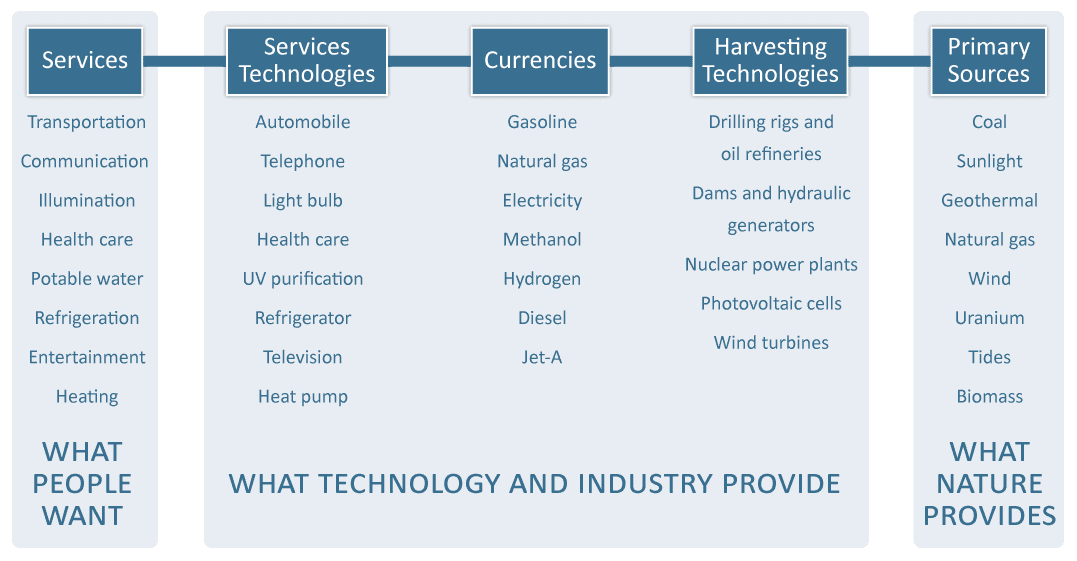Energy systems
Energy systems connect the energy resources that nature provides to the energy services that people want (see figure below). A wide range of harvesting technologies are used to convert the energy resources into currencies or commodities that we use to move energy to where it is needed to provide an energy service. The ultimate service requires the engagement of services technologies. For example, personal mobility (the service) requires a car (the service technology) fueled with gasoline (the energy commodity), that was typically produced in a refinery (harvesting technology) fed with crude oil (primary energy source).
We have chosen to show the energy service on the left side of this diagram to emphasize the important role that service demand places on the flows through the energy systems.
Architecture of energy systems
Adapted from David Sanborn Scott, Smelling Land. The Hydrogen Defense Against Climate Catastrophe, 2008
Showing energy systems' flows
Sankey diagram is a typical academic chart to represent energy flows, such as those involved in energy systems. Energy flow is represented by lines whose thickness corresponds to the quantity of energy that is flowing. They usually represent energy systems from the production side (energy primary sources) to the end-use (energy services), break down flows into energy commodites, and display energy transformation processes. Some also display the waste energy. The following Sankey diagram is based on the CanESS model and represents Canada's energy system in 2010.
Canada’s Energy System in 2010: a Sankey Diagram
Source: ISEEE/CanESS
Energy mix
The energy mix refers to the shares of various primary energy sources in the energy supply of a given region or country. The composition of an energy mix depends on four main drivers: the resources' availability, the extent and nature of the energy needs to be met, the economic, social, environmental and geopolitical context, as well as the political choices to develop certain technologies or havest specific energy resources.
With primary energy resources as various as crude oil, natural gas, hydropower, wind, biomass, solar, geothermal, uranium, Canada is an ‘energy powerhouse’ with plethora of options to meet its own needs as well as the needs of others. However in the Canadian confederation, energy is a provincial, not a federal responsability and resources are not equally distributed among provinces. As a consequence, provinces' energy mixes for electricity vary a lot between provinces: while Newfoundland and Labarador, Quebec, Manitoba and British Columbia meet the great share of their needs with hydroelectricity, Ontario has developped nuclear and Atlantic provinces, Saskatchewan and Alberta massively rely on coal.
Energy conversion efficiency
Energy conversion efficiency refers to the ratio between the output of an energy technology and the input, in energy terms. As energy systems consist of a set of technologies which transform primary energy into services, the energy conversion efficiency of each of these technologies is a critical factor for the system's efficiency and determine its waste energy. For instance, the energy conversion efficiency of an incandescent light bulb to produce light is ~10%, to be compared with a LED that can achieve 35%. As another example, coal power plants typically have an energy conversion efficiency of 33% in converting thermal energy in electricity through a steam turbine, while some combined-cycle gas-fired plants can reach 60%.
Selected references
- Pollution Probe, Primer on Energy Systems in Canada, 2011. URL: http://www.pollutionprobe.org/energy/energyliteracy/energy_primer.asp
- David Sanborn Scott, Smelling Land. The Hydrogen Defense Against Climate Catastrophe, 2008


